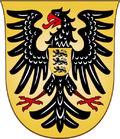Kaisers of the Eisenreich
| Kaiser/Kaiserin of the Eisenreich | |
|---|---|
 | |
| Incumbent | |
 | |
| Konrad IX von Hohenhoff since 15 February 1973 | |
| Details | |
| Style | His/Her Imperial Majesty |
| Heir apparent | Felix, Crown Prince |
| First monarch | Leutpold I Batavin |
| Formation | 238 |
| Residence | Eiserner Kaiserpalast, Eisenwald |
The Monarchy of the Eisenreich is the constitutional monarchy of the Eisenreich, and its Commonwealth of Realms. The monarchy is a hereditary position whose incumbent is styled the Emperor or Empress (Ermanic:Kaiser/Kaiserin"). The monarch also serves as the country's head-of-state.
The current monarch and head of state is Konrad IX von Hohenhoff, who assumed authority as Kaiser of the Eisenreich on February 15, 1973.
The Eisenreich monarchy has its origins in the First Ermanic Empire which dominated the area of the northern Eisenreich following the fall of the !NotRome. The modern Eisenreich monarchy traces its ancestry back to the rulers of the First Ermanic Empire which collapsed in the 6th Century CE. The Eisenreich monarchy has joint powers with the civilian government and retains authority through the Charter of the Iron Throne, though there is a relative precdent that the Emperor remain out of the day to day affairs the current incumbent has a tendency for flexing opinion and bending the civilian government to his long term goals. True power is thought to lie within the Imperial Palace rather than the Chancellor or the Landtag.
Succession Laws
List of Monarchs
First Ermanic Empire (238-580)
House Batavin (238 - 536)
House Batavin (Batavine) ascended to the throne following the long and arduous Unification Wars lasting from 204-238 which were finally completed under Leutpold I. In 238 Leutpold Batavin was the first ruler to be crowned sovereign of the Ermanic Empire. The first to reign in this new era was Leutpold I and the last of his line would be Leutpold II in 536, who with no legitimate heirs would see the throne descend into the Scorned Interregnum and that Conrad I Anhauser would be the next Emperor of the First Empire.
Scroned Interregnum (536-538)
The Scorned Interregnum was the direct result of Emperor Leutpold II of House Batavin dying without a legitimate heir. Two dukes rose to challenge each other for the throne resulting in a brief civil war where the two fought it out before finally Conrad of House Anhauser of the Alten Duchy would march to the capital and unseat the last of the pretenders and assert himself as the new Emperor.
House Anhauser (538-580)
House Anhauser seized the throne from the Pretenders during the Scorned Interregnum under the leadership of Conrad I. Conrad would serve as the first emperor from House Anhauser and the last of this line would be Maximilian I. The First Ermanic Empire would be dissolved at the Diet of Altenburg in 580.
Adlerreich (707-905)
House von Salz (707-905)
The House von Salz was born from the Salt Union between the Kingdoms of Batavia and Louvain following the intervention of His Holiness !Pope (NAME) in the Mirror War. The children of the new union between the Kingdoms were the first to be proclaimed Emperor of the Adlerreich. The First to reign was Emperor Conrad II and the last was Conrad V. The Adlerreich would cease to exist in 905 at which time a Diet held by the Crown Council Regency would abolish the Empire and proclaim the short lived Ermanic Confederation which would only last till 908 and the establishment of the Löwenreich under House von Löwen.
| Portrait | Name | Sovereign Number | Monarch from | Monarch until | Claim | Title |
|---|